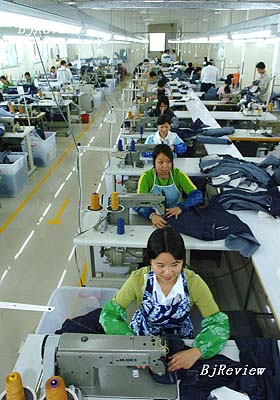|

The past four years have seen China's trade surplus soar. It accounted for 7 percent of the country's gross domestic product (GDP) in 2006. Indications are that this will exceed 10 percent in 2007. Given the swelling trade surplus and its rising proportion to the GDP, many people conclude that China's economy is seriously imbalanced. Li Yang, Director of the Institute of Finance and Banking, the Chinese Academy of Social Sciences, recently shared his views on the issue in an article in Wen Hui Bao, a Shanghai-based newspaper.
As a developing country in the process of reform and opening up, China is involved in the tide of restructuring the global division of labor. Its seemingly infinite labor supply and the gradually improving infrastructures are making China an ideal place for product processing and assembling and also other labor-intensive working procedures in the international production chain.
China's WTO accession was followed by further relaxed control in various areas, which continues to boost the confidence of transnational corporations in the country's economic growth and encourages them to relocate the last link of the production chain to China, selling masses of the finished products to the international market. As the price of the finished products covers the cost of workers' wages, overheads and includes profits, plus other added value gained in China, it is naturally higher than prices of imported components or parts, semi-finished products and raw materials. Given the current method of trade accounting, it is this price difference that contributes to China's trade surplus.
All in all, the new science and technology revolution has changed the comparative advantages countries had in the past and has led to the restructuring of the global division of labor. However, the economic restructuring caused by the change in the global division pattern is developing at different rates in different countries. Generally speaking, labor-intensive production and services are always outsourced to the developing world, such as China. Developed countries have to wait longer for the emergence of new job opportunities and export advantages. Therefore, trade imbalance in individual countries tends to grow.
Michael Spence, the 2001 Nobel laureate in economics, has said that income growth comes from three aspects-investment, application of technology and the practical knowledge, and the increase of labor force in departments of high productivity. The last point is very important at the early stage of economic development, because to transfer surplus labor from traditional industries to sectors of higher productivity is a very important driving force for economic growth.
As far as China is concerned, to transfer its surplus rural labor to the labor-intensive link of the global production chain obviously is the best channel to promote productivity. On one hand, it will help China's labor force to work together with global investment, technologies and management; on the other hand, it will create the best opportunity for Chinese workers to learn more, so that China can quickly build up a human resource reservoir. The accumulation of human resources in turn will attract more international manufacturers to invest in China, contributing to a virtuous circle in favor of China's industrialization.
To transfer up to 200 million surplus laborers to industrial sectors of higher productivity is the most significant labor transfer in human history. China is unlikely to manage this transfer by solely relying on its own domestic market, as this will require a large amount of investment at home, yet its current investment growth rate is already very high. Transferring the labor force to the process manufacturing industries and exporting the products with the added value of the labor force, China is indirectly "selling" its labor force to the international market. By focusing on the last assembly link in the global production procedure, the country is able to secure more employment opportunities and increase the salary income of its workforce. This is the key for China's success in tapping into its surplus labor force. Considering that China still has a large amount of rural surplus labor, in the coming decade and even beyond, it's necessary for the country to further obtain bigger market share in labor-intensive sectors in the global production chain, which means the trade surplus will remain through China's economic development.
Industrialization and urbanization will remain the basic themes in China's future development. It demands a long-term and large-scale labor force transfer to achieve the two goals, and a big supply of job opportunities is crucial for its achievement. Domestically, it's necessary to keep a relatively high investment rate for many years to come, so as to create conditions to absorb these labor forces; globally, it's necessary to transfer labor force to the international market through foreign trade.
If this is a reasonable analysis, then it would be wrong to point a finger at long-term trade surplus. |
